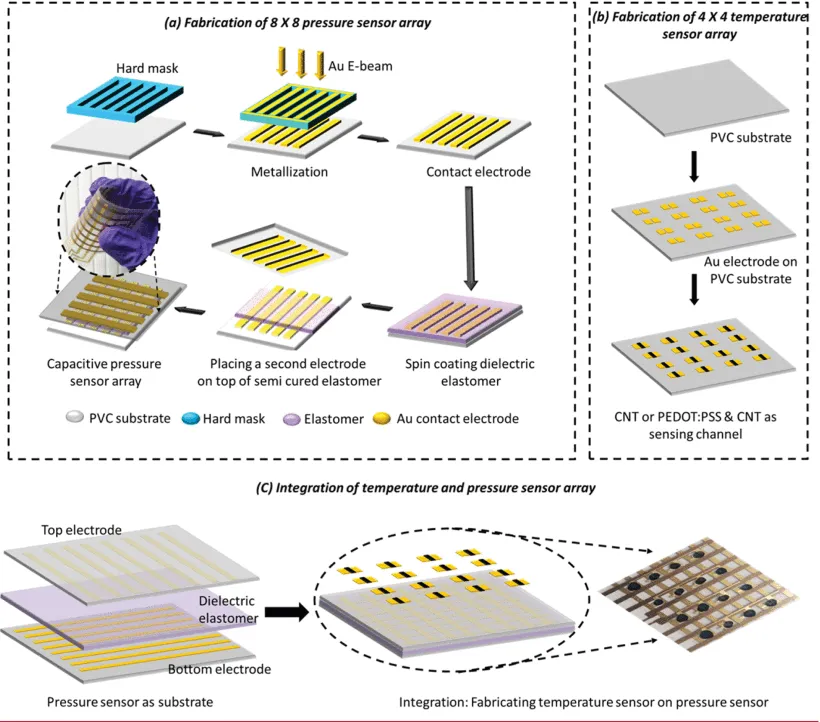Multifunctional Electronic Skin With a Stack of Temperature and Pressure Sensor Arrays
The skin is the largest organ of the human body and is capable of sensing different external stimuli such as pressure, temperature, and so on. Recently, there has been a burgeoning demand and interest for electronic skin (e-skin) with various soft and flexible sensors. Such e-skin can extract high-dimensional information from the environment for key applications such as robotics, healthcare, intelligent human-machine interfaces, etc. Donning robots with such e-skin will enable them to have human-like capabilities and significantly improve human-robotic interaction, making it possible for humans to interact effectively with robots in a safe manner.
It's important to understand the structure of the human skin to achieve human-like artificial skin via electronics. The knowledge will aid in the fabrication of sensors capable of mimicking the various sensory receptors embedded in the skin, such as the nociceptors (for pain sensation), thermoreceptors (for temperature sensation), and mechanoreceptors (for pressure). For instance, to detect external pressure like mechanoreceptors, researchers have reported a wide variety of pressure sensors using different transduction methods (e.g., capacitive, resistive, triboelectric, piezoresistive and piezoelectric etc.). Similarly, the sensing functionality of thermoreceptors has been mimicked through sensors that measure temperature either through direct contact with the heat source or remotely through radiations.
Following this, several versions of e-skin have been reported with the capability to measure a wide variety of stimuli such as pressure, temperature, proximity, slippage, etc. Still, the majority cannot detect more than one stimulus. This work reports a multifunctional e-skin with a stack of pressure and temperature sensor arrays. The e-skin is capable of measuring pressure and temperature simultaneously.
The fabrication process and characterization were divided into three main parts. Firstly, the pressure sensing layer was fabricated and characterized separately. Secondly, the temperature sensing layer was fabricated and characterized separately, and lastly, the pressure and temperature sensing layers were seamlessly and systematically integrated to realize a multifunctional e-skin. The capacitive sensing layer was fabricated by sandwiching an elastomeric dielectric layer between two gold electrodes. The electrodes were realized by depositing titanium /gold (10/80nm thick Ti/Au) on a 175 μm thick polyvinyl chloride (PVC) substrate. Three variants of the sensor were fabricated using dielectric materials of different stiffnesses to understand the role of material stiffness on the sensor performance. The capacitive pressure sensors were characterized by measuring the change in capacitance using an LCR meter connected to a PC running a custom-made LabVIEW.
Two different temperature sensors were fabricated using different active sensing materials, namely single-walled CNT and PEDOT: PSS mixed with single-walled CNT composite. In each case, the active material was drop-cast on a gold electrode realized by depositing 80nm of gold on 10nm of Titanium using an electron beam metal evaporator, cured and encapsulated. The temperature sensors were characterized by subjecting the sensors to temperature change using a hot plate and measuring the change in resistance of the sensing channel region using a digital multimeter connected to the sensor’s contact.
The results show that the e-skin can detect external pressure above 10kPa with a sensitivity of 2.32kPa-1 and temperature up to 80oC with a sensitivity of 0.64(%)/(oC).
The multifunctional e-skin presented here could strengthen the advancements in areas such as health care, robotics and intelligent interactive systems.




